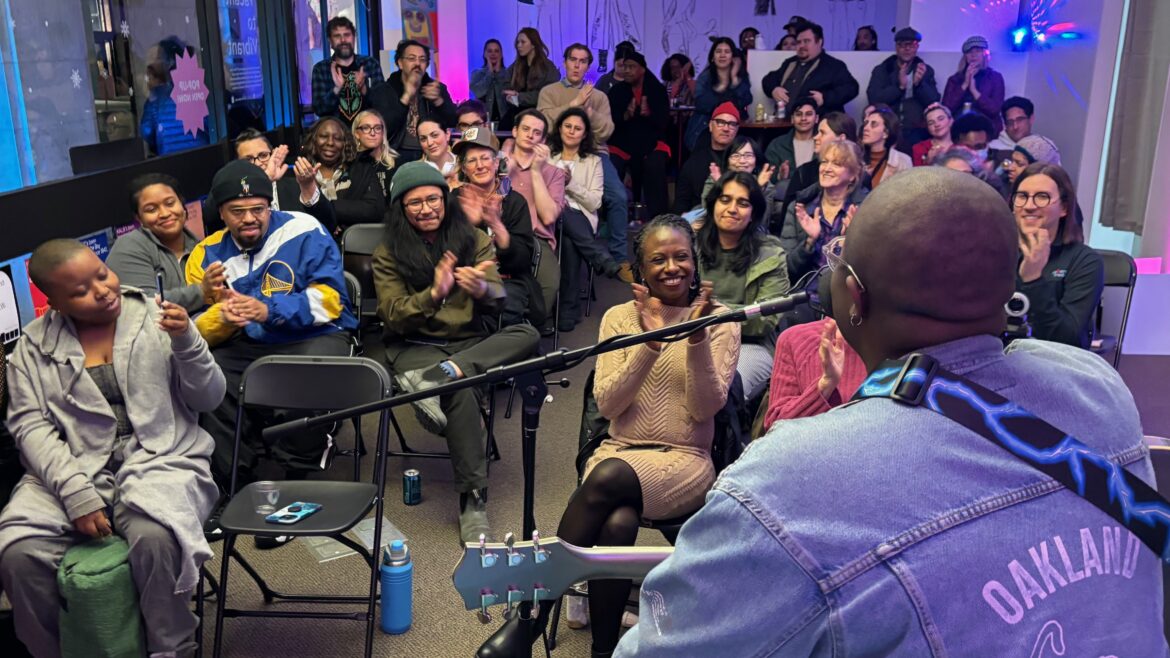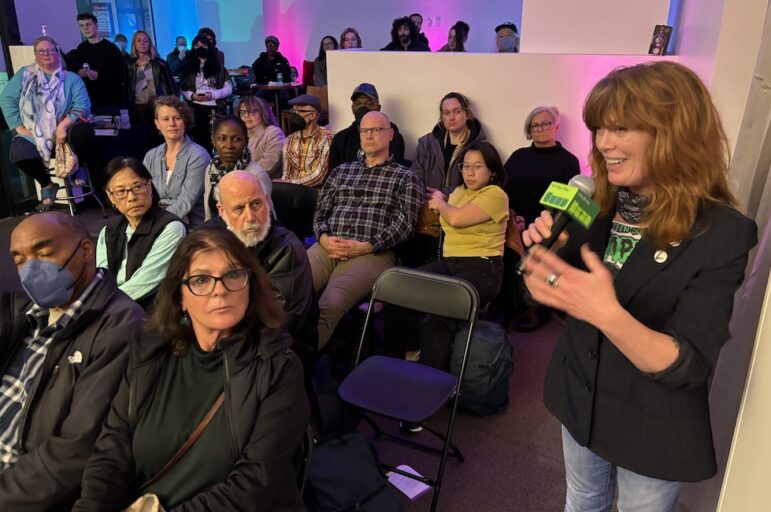How KALW opened up new possibilities with a downtown live event space

Ben Trefny / KALW
B DeVeaux, a 23-year-old nonbinary neo-soul artist and composer from Oakland, Calif., performs during "Sights & Sounds After Dark: The Love Factor," a KALW program on Feb. 15.
You may have heard about San Francisco’s “Doom Loop.” The city has struggled with office vacancies since the pandemic began, and the national media has often portrayed San Francisco as increasingly inhospitable.
That’s the backdrop for the “Vacant to Vibrant” program, in which a coalition including the city developed partnerships to offer six months of free rent in long-empty downtown storefronts. They had nine spaces for their first cohort. They got 900 applicants.
KALW wrote a proposal to take the news, information, music and cultural radio programming we’re known for and translate it into live downtown events. With that idea, we won a space and transformed the scope of what we do as a public media outlet.
Let me give a little background. KALW has been around for more than 80 years. In fact, ours was the first FM station west of the Mississippi River. During that time, we’ve created and been the first to carry many radio programs. We’ve also done a lot of great work training new generations of audio journalists.
But the pandemic and other factors have reduced our audience in recent years, so we decided to emphasize building awareness about what we do. Expanding into live event production seemed like a promising avenue to showcase our work.
The space we were granted, it turned out, was way bigger and better than we’d expected. It was about 4,000 square feet with huge, plate-glass windows right on Montgomery Street — what was once known as “the Wall Street of the West” — and just two blocks from a bustling public transportation station. It was a former Ricoh copy center, with a very visible front display room, two expansive internal rooms that could be used as conference and open-office space, a back area for more desks, two offices with closing doors, two bathrooms and a kitchen area. Our longtime home — located in a transformed wing of a public high school on the opposite side of town — totals about 5,000 square feet, so we could comfortably move most of our operations to the new facility with some strategic planning.
As part of the opportunity, we received about $8,000 to get us going. That largely went to audio equipment such as speakers, mixers, mics, cables and acoustic tiles, as well as some large-scale window decals branding the space with KALW’s logo. We didn’t have a lot of cash to build out this second headquarters, so I filled out what we needed with inexpensive or free Craigslist finds, including a conference table, office chairs, couches and kitchen appliances. It was a bit of a shabby chic look, but our team is pretty low maintenance (and was psyched for the more accessible location).
For the public space, we bought 40 folding chairs, brought over dozens more we had in storage, picked up some bar tables and high chairs, and put up a freestanding KALW backdrop behind an area we’d use as a stage. We also got a nice loan of two dozen uplights from a friend in the events business to make everything look shiny at night.
Mixed results, then momentum
We had a soft launch karaoke party on the 21st night of September, and our news team moved in shortly after, working primarily regular daytime hours in the office areas. Our first publicized event happened Oct. 5: an evening discussion about the state of downtown San Francisco that I conducted with an elected district supervisor, a community advocate and a journalist who grew up in the area. Nearly 100 people packed the front room, with several more watching through the windows and listening to a speaker we placed outside. It was a splashy success.
Everything that came after was not. We held an arts panel discussion that drew fewer than 20. We tried several happy hours with live DJs (pulling single-day beer and wine permits from the state Alcoholic Beverage Control) and got just a trickle of interest from the head-down work-a-days passing by on Montgomery.
But we kept trying new programs, learning as we went, and figuring out the marketing angles that would draw attention. We promoted Eventbrites, did on-air and newsletter advertising, and distributed physical postcards with stickers previewing upcoming events. All the while, we were creating civic-minded content in our own space, which enabled us to record, edit and then broadcast meaningful programming to our audience on the air, recorded before a live audience. That guaranteed exponentially larger audiences regardless of the in-person turnout.
By the end of January, we were running an average of four events per week, including a run of 11 in 14 days. Our momentum really grew. We started averaging more than 50 people per show, with a supervisorial debate to kick off the 2024 election season drawing a huge overflow crowd topping 110 highly engaged people.

Despite having little to no previous experience, we’ve now hosted 45 live events at 220 Montgomery Street. They’ve included town hall conversations with the most recognizable local leaders about education, electrification, homelessness, housing, transportation, journalism and more. We’ve hosted bands, nationally famous DJs and internationally renowned musicians. We’ve featured poets, filmmakers, writers and activists, plus all kinds of community members singing karaoke. We’ve developed relationships with sponsors who provide us with free food and drinks for our audience every week. We’ve also built a cohort of volunteers who come regularly to set up the room, bartend, clean up after events and spread the word.
New opportunities
As we approached the end of the six-month residency in February, our landlord looked at how we transformed what had been an empty storefront into a dynamic showplace. They considered how we had created a community in a struggling district. And we negotiated a mutually beneficial deal that enabled us to stay.
That unexpected outcome itself has been transformative for KALW. But much more than that has come from our expansion into producing live events. As part of the city’s efforts to revitalize downtown, we’ve earned a lot of local and national media attention. Scripps News sent a video reporter across the country to make a syndicated national feature about us and the Vacant to Vibrant program. The New York Times wrote a story about resurgent Montgomery Street, including KALW as a focal point. And in the Bay Area, there’s been much more.
Our new reputation has led to many opportunities. We’ve built a relationship with the Cal Academy of Sciences, broadcasting live DJ sets from their weekly NightLife events and developing plans for new informational programs. We’ve partnered with several other community-minded outlets in our space and theirs, leveraging each other’s audiences to build buzz. And we were invited to be an anchor programmer for a new monthly events series in San Francisco called Downtown First Thursdays where, over five hours, we’ll bring together elements of circus, drag, storytelling, town hall conversation and live music to a central stage before a roaming audience of up to 10,000 people.
We got a jump start, for sure, with the initial opportunity. And it’s taken investment — of time, money, and intention. But we’re already charting a pathway to self-sustainability for our new community events hub, and I expect diversified funding sources including membership, sponsorship, donations for tickets, and space rentals will get us there. Meanwhile, the awareness we’ve built in the Bay Area is invaluable.
The narratives continue about what this city is. We’re part of the conversation, now, about what it is becoming. Beyond that, while staying true to our mission as a public service provider, we’re expanding our vision of what public media can and should be today. It’s making a difference for us here in San Francisco. And it seems to me that pursuing a variation of this playbook can provide a meaningful difference for anybody working in this space across the country.
Ben Trefny is executive producer at KALW.






This a really cool success story!